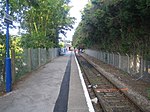Marlow By-pass Bridge
Berkshire building and structure stubsBishamBridges across the River ThamesBridges completed in 1972Bridges in Berkshire ... and 5 more
Bridges in BuckinghamshireBuckinghamshire building and structure stubsRoad bridges in EnglandUnited Kingdom bridge (structure) stubsUse British English from October 2017

Marlow By-pass Bridge is a road bridge across the River Thames in England. It carries the A404 road between Maidenhead, Berkshire and High Wycombe, Buckinghamshire. and crosses the Thames on the reach between Cookham Lock and Marlow Lock. The bridge forms part of the Marlow by-pass to the east of the town. It was built in 1972. The area underneath the bridge is used for boat storage by the adjacent outdoor adventure centre at Longridge (a registered charity).
Excerpt from the Wikipedia article Marlow By-pass Bridge (License: CC BY-SA 3.0, Authors, Images).Marlow By-pass Bridge
A404,
Geographical coordinates (GPS) Address External links Nearby Places Show on map
Geographical coordinates (GPS)
| Latitude | Longitude |
|---|---|
| N 51.566111111111 ° | E -0.76194444444444 ° |
Address
Marlow By-pass Bridge
A404
SL7 1QG , Bisham
England, United Kingdom
Open on Google Maps








